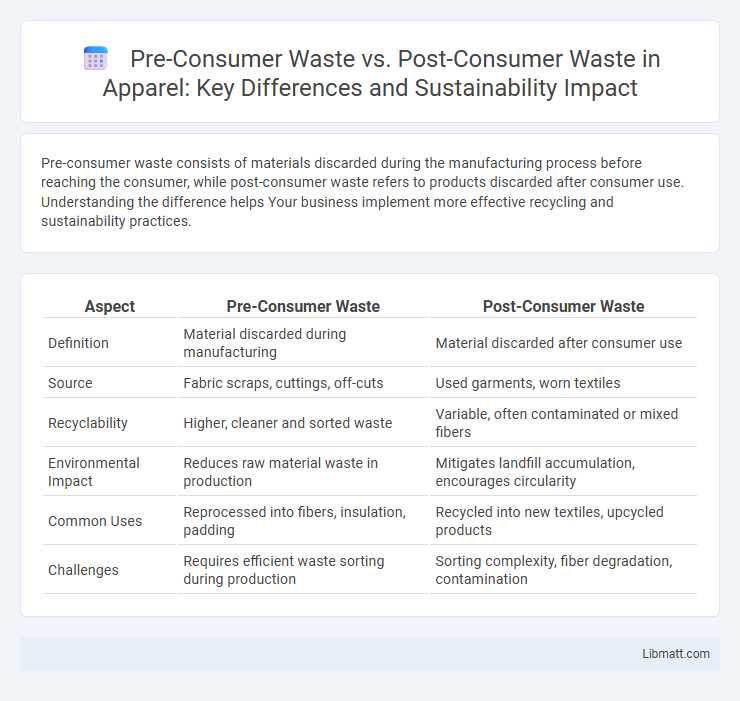Pre-consumer waste consists of materials discarded during the manufacturing process before reaching the consumer, while post-consumer waste refers to products discarded after consumer use. Understanding the difference helps Your business implement more effective recycling and sustainability practices.
Table of Comparison
| Aspect | Pre-Consumer Waste | Post-Consumer Waste |
|---|---|---|
| Definition | Material discarded during manufacturing | Material discarded after consumer use |
| Source | Fabric scraps, cuttings, off-cuts | Used garments, worn textiles |
| Recyclability | Higher, cleaner and sorted waste | Variable, often contaminated or mixed fibers |
| Environmental Impact | Reduces raw material waste in production | Mitigates landfill accumulation, encourages circularity |
| Common Uses | Reprocessed into fibers, insulation, padding | Recycled into new textiles, upcycled products |
| Challenges | Requires efficient waste sorting during production | Sorting complexity, fiber degradation, contamination |
Understanding Pre-Consumer Waste: Definition and Examples
Pre-consumer waste refers to materials discarded during the manufacturing process before reaching the consumer, including scraps, trimmings, and defective products. Examples include textile offcuts from garment production and paper trimmings from printing facilities. Understanding your role in managing pre-consumer waste can help reduce environmental impact by promoting recycling and reuse within industrial operations.
What is Post-Consumer Waste? Key Characteristics
Post-consumer waste refers to materials discarded after they have been used by consumers, such as packaging, old papers, and used plastic containers. Its key characteristics include being collected from residential or commercial waste streams and having undergone its intended lifecycle before disposal or recycling. Understanding post-consumer waste helps improve your recycling practices and supports sustainable resource management.
Sources of Pre-Consumer Waste in Manufacturing
Pre-consumer waste in manufacturing primarily originates from raw material off-cuts, defective products, and production line trimmings before reaching the consumer. Common sources include fabric scraps from textile mills, metal shavings from machining processes, and paper trimmings from printing facilities. Efficient management of pre-consumer waste enhances resource recovery and reduces landfill impact in manufacturing sectors.
Common Sources of Post-Consumer Waste in Daily Life
Post-consumer waste commonly originates from household items such as packaging materials, food containers, newspapers, and electronic waste discarded after consumer use. Other frequent sources include used clothing, batteries, and plastic bottles that enter municipal waste streams. Proper management of these materials is essential to reduce landfill impact and support recycling programs.
Environmental Impact: Pre-Consumer vs. Post-Consumer Waste
Pre-consumer waste consists of materials discarded during manufacturing, typically clean and easier to recycle, reducing energy consumption in production processes. Post-consumer waste is generated after product use, often mixed and contaminated, posing greater challenges for recycling facilities and contributing more significantly to landfill overflow and pollution. Understanding the environmental impact, managing both waste types effectively can lower your carbon footprint by minimizing resource extraction and reducing greenhouse gas emissions.
Recycling Opportunities: Which Waste Stream is Easier to Recycle?
Pre-consumer waste, generated during manufacturing before reaching consumers, is easier to recycle due to its consistent quality and uncontaminated state, allowing industries to efficiently reclaim materials like paper, plastics, and metals. Post-consumer waste, produced after product use, presents greater recycling challenges because of contamination and material diversity, requiring advanced sorting technologies to process items like packaging and electronics. Your recycling efforts can be more impactful when focusing on pre-consumer waste streams, as they offer higher recovery rates and lower processing costs compared to post-consumer waste.
Economic Implications of Managing Different Waste Types
Managing pre-consumer waste, which consists of manufacturing scraps and unused materials, often incurs lower disposal costs and can be more efficiently recycled or repurposed within production processes, thus reducing overall expenses. Post-consumer waste, generated after product use by consumers, typically requires more complex collection, sorting, and treatment systems, leading to higher economic burdens for municipalities and businesses. Your strategic waste management decisions must weigh these cost differences to optimize resource recovery and minimize financial impact.
Role in Sustainable Supply Chains: Pre-Consumer and Post-Consumer Waste
Pre-consumer waste, generated during manufacturing processes, plays a crucial role in sustainable supply chains by enabling materials to be reclaimed and reintegrated before reaching consumers, thus reducing raw material extraction and production energy. Post-consumer waste, comprising products discarded after consumer use, drives sustainability through recycling and upcycling efforts that minimize landfill contributions and promote circular economy models. Integrating both types of waste management optimizes resource efficiency and environmental impact reduction across supply chains.
Policies and Regulations Governing Waste Management
Policies governing pre-consumer waste often emphasize industrial regulations and mandates for manufacturers to reduce excess production and optimize resource efficiency, guided by environmental protection agencies and sustainability frameworks. Post-consumer waste policies focus on consumer recycling programs, extended producer responsibility (EPR) laws, and municipal waste management standards aimed at reducing landfill use and promoting circular economy principles. Regulatory frameworks such as the Waste Framework Directive in the EU and the Resource Conservation and Recovery Act (RCRA) in the US set clear guidelines for waste segregation, recycling rates, and reporting requirements to improve both pre-consumer and post-consumer waste management outcomes.
Strategies for Reducing Both Pre-Consumer and Post-Consumer Waste
Implementing lean manufacturing processes and optimizing inventory management are effective strategies for reducing pre-consumer waste by minimizing excess materials and defective products. For post-consumer waste, promoting recycling programs, encouraging product reuse, and designing products for easier disassembly enhance waste diversion from landfills. Adoption of circular economy principles, such as material recovery and closed-loop supply chains, supports comprehensive waste reduction across both pre-consumer and post-consumer stages.
pre-consumer waste vs post-consumer waste Infographic

 libmatt.com
libmatt.com